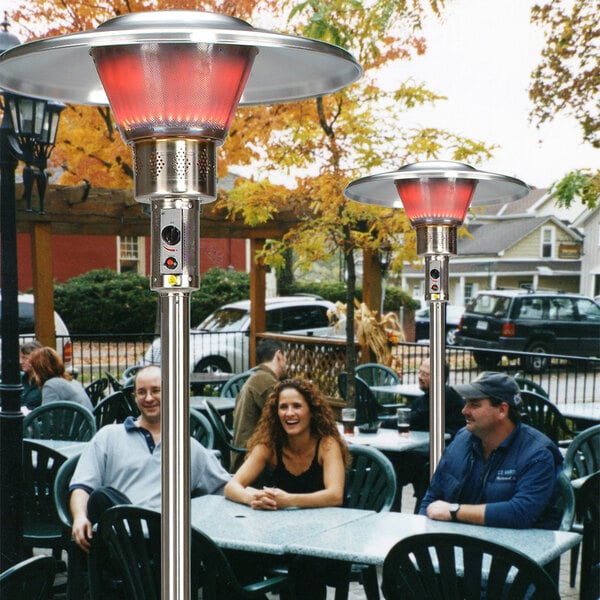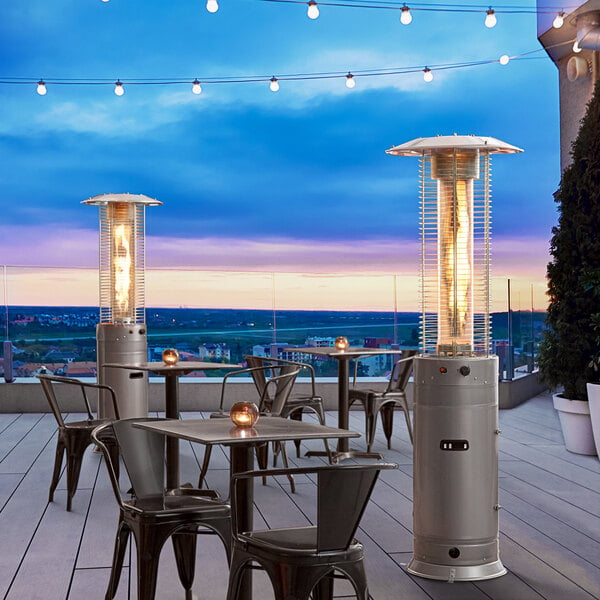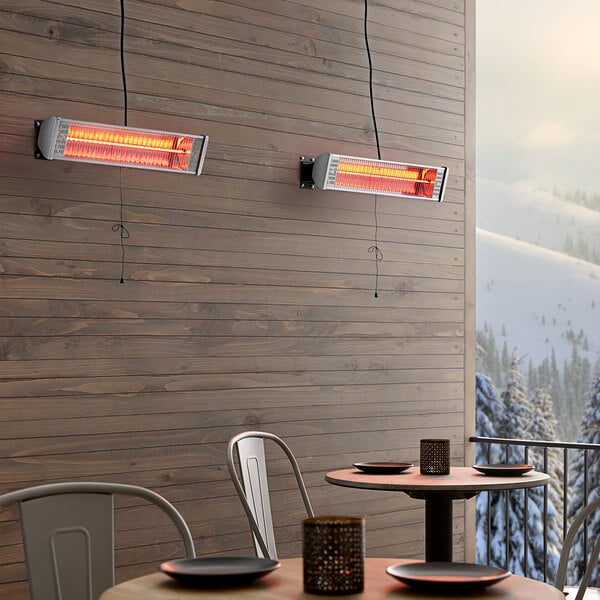
Patio Heater Troubleshooting
Patio heaters are essential for any business operating an outdoor eating space during the winter. They provide much-needed warmth and allow customers to comfortably dine outside year-round. However, even the most reliable patio heater brands can experience issues from time to time. With an understanding of the common issues that affect patio heaters and how to alleviate them, you can keep your heaters in good condition all season long and make sure you know what patio heater parts and accessories to buy.
Shop All Patio Heaters
Whether you have a gas patio heater or an electric patio heater, it's essential to make sure the unit activates correctly. Verifying that your heaters will light and stay lit ensures the comfort and convenience of your guests.
Patio Heater Won't Light

Several factors can prevent your patio heater from lighting. Inspect the following components to identify what is causing the issue and fix the problem.
- Debris buildup on the pilot: Over time, dust, dirt, and other particles can accumulate around the pilot, preventing the heater from igniting. Regularly check for debris and clean any buildups to avoid this issue.
- Low gas pressure: Confirm that the gas cylinder connected to the heater has sufficient fuel and that there is no damage to the connection. A loose or damaged connection can lead to low fuel pressure, preventing the heater from igniting. If you suspect a damaged connection, replace the faulty parts to restore proper gas flow and pressure.
- Gas leak: Leaking connections and damaged gas lines may prevent ignition. If you suspect a leak, inspect the gas lines for any signs of damage, such as cracks or corrosion. Gas leaks can be hazardous, so always prioritize safety and immediately seek professional help if you find one.
Patio Heater Won't Stay Lit
If you're experiencing issues with your patio heater not staying lit, troubleshooting a solution will depend on whether you have a gas or electric model. We'll outline what to look for on each type of heater below:
- Gas patio heater: The most likely cause of a gas patio heater that won't stay lit is a damaged gas line. Assess the line for a poor connection or wear and tear to identify the source of the issue. If you're unsure of how to replace or repair your gas line, it's best to contact a service professional who can assist you.
- Electric patio heater: If you have an electric patio heater that won't stay lit, the most common cause is damaged wiring. Inspect the wiring for signs of corrosion, grayed coloring, or damaged insulation. Additionally, check the surrounding area for any environmental exposure or rodent infestations. To ensure the safe repair of damaged wiring, contact a service professional.
A regulator controls the flow of propane and natural gas from the cylinder to the burner and is a crucial component of your patio heater. There are a variety of issues that may affect your regulator's effectiveness, and we've listed the most common below.
- Regulator won't connect to the gas cylinder: In most cases, the reason a regulator won't connect to a gas cylinder is because the cylinder is the wrong size. Verify that your cylinder valve and regulator are compatible to achieve a proper connection.
- Regulator freezing up: A freezing regulator is typically caused by the improper flow of liquid propane. To prevent this issue, only use propane tanks that are designated for use with patio heaters. If your regulator continues freezing up, contact a service professional for assistance.
- Gas not passing through the regulator: Check that all of your connections are secure and there are no blockages in the gas line if gas isn't passing through the regulator. If no blockages are present, you may need to reset your regulator or contact a service professional for assistance.
Flame issues can significantly affect the performance of your patio heater, and it's important to resolve them promptly. Failure to do so can cause damage to the unit and put your guests in danger.
Patio Heater Flame Is Too High

A flame that is too high will cause your heater to operate ineffectively. If you notice that your flame is higher than it should be, inspect the following components:
- Damaged thermocouple: The thermocouple detects the presence of a flame and allows gas to flow through the burner. Over time, it can become worn out or damaged, leading to an erratic or excessive flame. Examine it for any signs of discoloration, cracks, corroded wires, or defective connectors, and contact a maintenance professional for assistance if needed.
- Faulty safety switch: Patio heaters feature a safety switch that automatically shuts off the gas supply if the unit tips over. If this switch is malfunctioning, it can cause an erratic flame. If you suspect a problem with your safety switch, contact a maintenance professional.
- Incomplete combustion: Any interference with the combustion process can cause your flame to rise or fall significantly. To address this problem, assess your burners for any signs of corrosion or blockages. Low gas pressure or a clogged air intake can also contribute to incomplete combustion, and a key indicator that it is occurring is a yellow flame.
Patio Heater Flame Is Too Low
A low patio heater flame will not generate enough heat to keep your guests warm. If you notice that the flame on your unit is not reaching the desired height, several variables may be to blame.
- Low gas pressure: Insufficient gas pressure can result in a weak flame that does not provide enough heat. To check for this issue, ensure that your propane tank is fully open and that there are no restrictions on the gas line. Additionally, make sure that the gas valve on the heater itself is fully open.
- Damaged regulator assembly: A damaged regulator assembly will restrict gas flow to the burner. Inspect the regulator for any signs of damage or wear and consider replacing it if necessary.
- Blocked burner orifice: Debris buildup on and around your burner orifice can lower its effectiveness. Clean your burners as needed to avoid debris buildup.
- New propane tank: If you are using a new propane tank that hasn't been purged of air, your flame will struggle to rise. Purge your tank before use to avoid this issue, as air trapped inside the tank can disrupt gas flow.
- Damaged gas hose: Over time, your gas hose may become twisted or tangled, restricting gas flow to the burner. Assess the gas hose for any kinks, bends, leaks, or cracks. If you identify any issues with the hose, replace it with a new one to ensure safe and efficient operation.
Patio Heater Has a Yellow Flame
In most cases, your patio heater's flame should be blue. A yellow flame indicates an improper oxygen ratio for combustion and should be promptly fixed to ensure the safety of your staff and guests.
- Dirty or clogged burner orifice: Regular cleaning of the burner orifice is essential to maintain optimal performance and proper flame color. Refer to your heater's user manual for cleaning instructions.
- Clogged air intake: The air intake of your patio heater may become clogged with buildup or debris, preventing oxygen from properly mixing with the gas and causing a yellow flame. Remove blockages from the air intake to alleviate the issue.
- High humidity: In areas with high humidity, moisture can affect the combustion process. This excess moisture can affect flame color, potentially turning it yellow. If you frequently experience high humidity, it may be necessary to consider purchasing a patio heater designed to accommodate your climate.
Also referred to as a pilot light, the pilot is a small gas flame that helps to ignite gas burners. If it does not stay lit, your patio heater will not be able to function.
- Drafts: Even a slight breeze can disrupt the flame and cause it to extinguish. Position your heater in an area sheltered from wind and the elements. If necessary, consider relocating the heater to a more protected spot.
- Gas flow obstructions: Confirm that there are no kinks, twists, or leaks in the gas supply line. Additionally, examine the gas valve and regulator for any signs of damage or blockages.
- Dirty burners: Regularly clean the burner to remove any obstructions.

A properly functioning patio heater should operate quietly, providing a comfortable and peaceful outdoor environment. However, there are instances where a patio heater may start making abnormal noises. While certain noises may be harmless, you should consider maintenance if you hear any of the following sounds regularly:
- Fluttering: A fluttering sound suggests a problem with the exit nozzle for the gas supply. Carefully look over the nozzle for any signs of damage or blockage and replace it with a new one to stop the sound.
- Hissing: If your patio heater is making a hissing sound, it is likely that the gas supply is not flowing correctly. In such cases, check that the tank valve is fully open.
- Popping: A popping sound indicates damage or corrosion within the patio heater. Clean your heater and replace any damaged parts to alleviate the issue.
- Rattling: Rattling indicates that loose components, fasteners, or debris may be stuck in the fan. Inspecting the fan and its surroundings for foreign objects will stop the sound from occurring.
- Screeching: When your heater is making a screeching sound, the motor may be damaged. This can be caused by various factors including insufficient lubrication and worn-out bearings. Contact a service professional for assistance if one or more of these components needs maintenance.
- Whistling: A whistling sound is the result of a clogged or improperly adjusted gas regulator. To get rid of this sound, carefully examine the regulator, nozzle, and connections for any blockages or misalignments. Adjust the gas regulator and clean any obstructions to resolve the issue.
Related Resources

How to Create a Profitable Patio Space
Whether you live in warmth all year long or you're looking to take advantage of the summer sunshine, consider transforming your unused or wintry outdoor space into a profitable patio destination. Outdoor dining areas range from simple sidewalk space to lavish poolside bars. To make the most of the beautiful weather, revamp your current patio to provide guests with outdoor dining options. Take into account the following restaurant patio ideas and considerations to transform your space into a profitable addition for your bar or cafe. Shop All Restaurant Patio Furniture Use these links to learn more about individual aspects of creating a profitable patio space: Check Restaurant Patio Laws and Regulations Designing a Patio Layout Prepare for In

Preparing Your Restaurant for Winter Weather
If your restaurant is located in an area that receives frequent snow during the winter months, chances are a snowstorm or other forces of nature can impact your business. Instead of worrying about bad weather, take the precautionary steps to keep your restaurant safe in the winter . Continue reading to learn more about a few ways you can prepare your restaurant for cold weather. Shop All Emergency Preparedness Supplies 1. Stock Up on Winter Supplies To properly prepare your restaurant for the winter , you will need to stock up on the right supplies. Winter storms and power outages seem to come out of nowhere, and very few people are ready for them ahead of time. Be sure to purchase these products before it starts to get cold. Emergency Wint

Winter Bar Promotions
In addition to preparing your premises for cold temperatures, you should implement a promotional plan to attract customers. Thanks to unfavorable weather conditions, freezing temperatures, and shorter daylight hours, many bars see a decrease in business during the winter months. Use our tips to entice people to venture out and generate profits throughout winter. Check out our winter bar promotion ideas: Invest in Bar Advertising Offer Seasonal Drinks Host Weekly Bar Events Foster a Warm Atmosphere Offer Game Day Promotions Host a Tasting Event How to Attract Customers to Your Bar in the Winter Winter can be a challenging time for bars to attract customers, but with the right promotions, you can create a warm and inviting atmosphere that wil
- Topics 1364
- Industrial 55
- Troubleshooting Guides 21
- Restaurant Management 129
- Bar Management 57
- Catering Tips 37
- Bakery Management 42
- Food Trucks & Concessions 49
- Advertising & Marketing 37
- Eco-Friendly Tips 11
- Facility Layout & Design 42
- Coffee Shop Tips 29
- Installation & Maintenance 52
- Janitorial & Pest Control 30
- Safety & Sanitation 88
- Startup Tips 104
- Menu Design 10
- Kitchen & Cooking Tips 84
- Hospitality Management 24
- Pizza & Sandwich Shop Tips 36
- Smallwares 37
- Food Prep 90
- Tabletop Items 17
- Disposables 22
- Calculators & Tools 6
- Consumables 52
- Warewashing & Laundry 19
- Cooking Equipment 92
- Food Storage & Refrigeration 51
- Beverage Equipment 35
- Office Supplies 6


